Take Action for Pumicestone Passage (TAPP) is a volunteer group whose aim is to protect and enhance the Pumicestone Passage environment and catchment. Our current core projects are shown on the PROJECTS page. We also share our knowledge with schools, community groups and U3A classes. Meetings are the second Tuesday of every month in Caloundra, and we have work bees periodically. Designated members are also actively working on projects on an ongoing basis. Our membership fee is $20/year and we welcome new members who wish to actively participate as well as those who simply wish to join to offer moral and financial support! For more information or membership application please click HERE.
About the Pumicestone Passage
This shallow estuary nestled between the mainland of Queensland and Bribie Island is approximately 35 kilometres long. It receives inflows from numerous small creeks and is subject to tidal flushing starting from Deception Bay, resulting in a slow net northern movement of water. The area contains a range of habitats including mangroves, saltmarshes, sand and mudflats, seagrass beds and coastal dunes. The rich feeding and breeding grounds support a wide variety of plant and animal communities.
Key species include:
- Approximately 350 species of marine invertebrates
- Over 60 fish species, it is a Declared Fish Habitat Area as it is an important hatchery for many species
- Over 300 species of birds, many of which are migratory
- Seven species of mangroves and seven species of seagrass
- Turtles species including the vulnerable Green and Hawksbill turtles and the endangered Loggerhead turtle
- Home to the endangered Dugong
Protection of the Pumicestone Passage
The Pumicestone Passage is protected by national and international instruments:
- Part of the Moreton Bay Marine Park
- Convention on the Conservation of Migratory Species of Wild Animals
- CAMBA, JAMBA, ROKAMBA, bi-lateral treaties with China, Japan and Korea protecting migratory species
- A recognised wetland under the RAMSAR Convention on Wetlands.
Threats to the Pumicestone Passage
The shallow nature of the Pumicestone Passage makes it an ideal nursery for a host of invertebrate, algae and seagrass which in turn support a myriad of marine and bird species. Events that can negatively impact on this sensitive food chain are:
- Increase in nutrients (eg. agriculture or forestry within the catchment)
- Increase in turbidity (eg. sediment from construction and bank erosion)
- Sediment deposits – potentially resulting in a change in water depth
- Influx of toxins (eg. stormwater runoff from urban and industrial areas)
- Changes in pH through disturbance of acid sulphate soils and runoff from urban and industrial areas
Here’s what WIKIPEDIA has to say about the Pumicestone Passage
